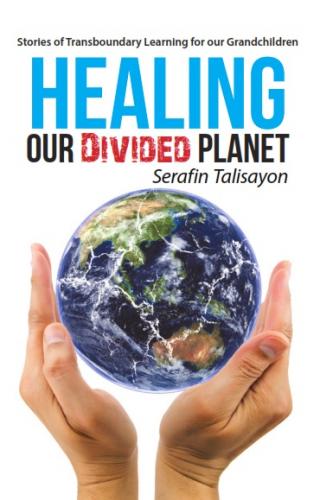CCLFI is proud to announce the publication of a new book by Apin Talisayon: "Healing Our Divided Planet: Stories of Transboundary Learning for Our Grandchildren". If you wish to contribute to world peace through small but meaningful actions in your own personal life, then this book is for you.
The book is available from Amazon.com (click on the link and type "talisayon" in the search engine) in hard cover, paperback and e-book formats.

About the book
There are many serious divides – political, religious, economic, and others – that threaten our planet. This book is about how individually we can contribute to healing the divides between us. Apin shares short readable stories and his own reflections from his life journey trying to understand, learn and find solutions to these serious divides. Because solutions will take time, he dedicates and addresses this book to his grandchildren and to your own grandchildren as well.
The stories’ titles beckon your attention or promise surprise or entertainment, such as “Stories of people who died and then came back,” “The sex act: a most private act with huge public consequences” and “The root causes of poverty are not economic.” The author loves to stimulate you to think and he enjoys offering you potential eye openers. After each story, subtitles of his reflections capture the valuable life lesson he wishes to share with you. Suggested actions follow many of the stories which readers can consider if they decide to contribute in healing the divides between us.
Why Apin wrote this book
The UNESCO Constitution started by saying that “since wars begin in the minds of men, it is in the minds of men that the defences of peace must be constructed.” Since UNESCO was established in 1945, wars and conflicts are still going on unabated. Little progress has been made in constructing defences of peace in the minds of men.
It often takes more than one generation before those in power take action after we realize that old ideas are no longer workable. Hence, he wrote this book for his grandchildren and others' grandchildren. Through this book Apin hopes that they and the generations after them will also see what he saw, and take action. Through these stories, he prays that you, too, will discover and awaken to the horrible divisions and conflicts happening around our planet and to their root causes, namely, hidden mental fences that many of us continue to harbor. The book suggests removing or reducing these mental fences through personal actions of "transboundary learning". The book gives examples of transboundary learning and innovation; click here to see examples of transboundary innovation.
We have many tools, professional areas of expertise and institutions for learning but there is a glaring lack of social capacities in the critical area of unlearning. Discovering our own hidden assumptions is a skill hardly taught in our schools. Cartoonist Walt Kelly, speaking through the boy in his comic strip, Pogo, said “We have met the enemy and he is us.” To be more precise, our enemies are the hidden assumptions inside our heads and we need to exert efforts and learn the skills of discovering and managing them. This is what the book is all about.
Table of Contents of the Book
Where We Are Today
Why Heal?
How “Horrible”?
Who Is Responsible?
Mental Fences Are Our Constructions
Our Poor Track Record in Changing Unworkable Ideas
How to Read This Book
1 Divides between Our Beliefs about Life and Death: Helping a Dying Friend
1.1 A Beautiful Vivid Dream and a Big Problem
1.2 Something Felt Different after a Short E-mail
1.3 I Can See Them, but They Cannot See Me
1.4 Stories of People Who Died and Then Came Back
1.5 A Story from My Grandmother: the Value of Intangibles
1.6 Counseling Is for the Living but Counseling for the Dead?
1.7 What Is Heaven Like?
2 Religious Divides: the Method of Abraham
2.1 A Government Training Course in Spiritual Governance
2.2 Abraham Had No Scripture to Depend On
2.3 Two-Way Prayer: Pray and Also Listen
2.4 Two Disempowerments
3 Political Divides: Fighting Terrorism with Drones?
3.1 Southeast Asian Nations Are Coming Together
3.2 “We Want Him to be Our S.O.B.”
3.3 Bridging What Divides Filipinos
3.4 Two Global Mega-Trends
3.5 Global Inclusivity
3.6 I Faced the Prospect of Losing Everything: Family, Career, Fortune and Even My Life
3.7 Governance in the Indigo Quadrant
4 The Divide between the Rich and the Poor
4.1 The Root Causes of Poverty Are Not Economic
4.2 What Indeed Is “Poverty”?
4.3 “The Sex Act: a Most Private Act with Huge Public Consequences” (Private-Public Divide)
4.4 Economic Empowerment of Local Communities
4.5 The Illusion of Separateness
4.6 If Karl Marx Were Living Today
4.7 My Beijing Talk: Exposing a Flaw in Corporate Governance
5 Gender Gaps Start inside Our Heads
5.1 Looking at Baby Agi for an Hour
5.2 “She Is Very Beautiful”
5.3 Global Rise of the Feminine
6 Gaps between Knowing and Doing
6.1 Two or More Generations before Those in Power Act on What We Know
6.2 I Don’t Have Exams in My Knowledge Management Classes
6.3 Bridging the Knowing-Doing Gap
6.4 The Doers Talk, and the Talkers Listen
6.5 Knowing How to Do and Willingness to Do It
6.6 The Success of a School Is a Failure in the National Economy
6.7 R&D Problems Should Come from the Business Sector
7 The Dancing Sun in Fatima: the Divide between Religion and Science
7.1 Where Did the Sourness of the Tamarind Come From?
7.2 Soft versus Hard Innovations
7.3 Birth of the Idea of “Conscious Living”
7.4 Internal versus External Attention: Isko and Esbert
7.5 A Pure Raw Experience
7.6 Our God Concepts
8 Healing Three Divides Within
8.1 The Nature-Human Disconnect
8.2 The God-Human Disconnect
8.3 The God-Nature Disconnect
9 To Our Grandchildren: a World without Bridges
Readings
